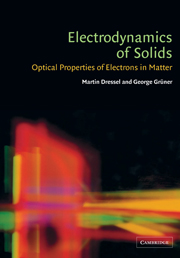Book contents
- Frontmatter
- Contents
- Preface
- 1 Introduction
- PART ONE CONCEPTS AND PROPERTIES
- PART TWO METHODS
- PART THREE EXPERIMENTS
- PART FOUR APPENDICES
- Appendix A Fourier and Laplace transformations
- Appendix B Medium of finite thickness
- Appendix C k·p perturbation theory
- Appendix D Sum rules
- Appendix E Non-local response
- Appendix F Dielectric response in reduced dimensions
- Appendix G Important constants and units
- Index
Appendix B - Medium of finite thickness
Published online by Cambridge University Press: 20 May 2010
- Frontmatter
- Contents
- Preface
- 1 Introduction
- PART ONE CONCEPTS AND PROPERTIES
- PART TWO METHODS
- PART THREE EXPERIMENTS
- PART FOUR APPENDICES
- Appendix A Fourier and Laplace transformations
- Appendix B Medium of finite thickness
- Appendix C k·p perturbation theory
- Appendix D Sum rules
- Appendix E Non-local response
- Appendix F Dielectric response in reduced dimensions
- Appendix G Important constants and units
- Index
Summary
In the expressions (2.4.15) and (2.4.21) we arrived at the power ratio reflected by or transmitted through the surface of an infinitely thick medium, which is characterized by the optical constants n and k. For a material of finite thickness d, the situation becomes more complicated because the electromagnetic radiation which is transmitted through the first interface does not entirely pass through the second interface; part of it is reflected from the back of the material. This portion eventually hits the surface, where again part of it is transmitted and contributes to the backgoing signal, while the remaining portion is reflected again and stays inside the material. This multireflection continues infinitely with decreasing intensity as depicted in Fig. B.1.
In this appendix we discuss some of the optical effects related to multireflection which becomes particularly important in media with a thickness smaller than the skin depth but (significantly) larger than half the wavelength. Note, the skin depth does not define a sharp boundary but serves as a characteristic length scale which indicates that, for materials which are considerably thicker than δ0, most of the radiation is absorbed before it reaches the rear side. First we introduce the notion of film impedance before the concept of impedance mismatch is applied to a multilayer system. We finally derive expressions for the reflection and transmission factors of various multilayer systems.
- Type
- Chapter
- Information
- Electrodynamics of SolidsOptical Properties of Electrons in Matter, pp. 406 - 420Publisher: Cambridge University PressPrint publication year: 2002
- 1
- Cited by



